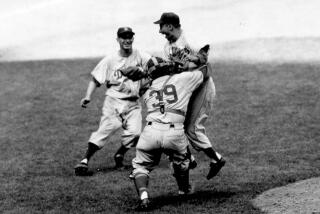‘Daring’ Competitor : Remembering Jackie Robinson 50 Years Later
Jackie Robinson always had fire in his eyes. There was an intensity in them, a determination from the lonesome odyssey of 1947 when he integrated baseball and changed America.
Those eyes saw things others did not. They would dart around the field, scouting defensive positions, always calculating how to beat the other team, maybe with his bat, perhaps with his glove, certainly with his speed.
Robinson had taken an oath of silence that rookie year, pledging to absorb the storm of vile abuse that baseball’s first black player would inevitably face and vowing not to answer any of it.
That season seemed to scar him permanently, planting in Robinson a fury to succeed, a fire that never could be extinguished. He was the centerpiece on six Brooklyn pennant winners and one world championship in his 10 seasons.
At the moment of his team’s most excruciating defeat, in 1951 when the New York Giants won the pennant on Bobby Thomson’s playoff home run, the downtrodden Dodgers trudged off the field, heads down, a beaten team. Robinson, however, stood defiantly at second base, hands on hips, eyes following Thomson around the bases to see if, in his exuberance, the Giants’ hero might miss one and nullify his homer.
It was typical of him, never willing to surrender.
Robinson, a second baseman for most of his career, was unmistakable on the diamond, a muscular, pigeon-toed man who walked with a short, mincing gait. The right-handed hitter would stand in the batter’s box with his feet planted wide apart, his bat held high and straight up.
Robinson was special on the bases. At a time when baseball was still plodding along one base at a time, Robinson was in overdrive, taking two and three at a clip. He was not terribly fast but he had a sixth sense about running the bases. He would dance off a base, challenging pitchers, daring them to do something about it, driving them crazy.
There would be one, perhaps two, maybe even three throws to keep him close. By then, the pitcher would be distracted and Robinson would be ready to run. It was one-up-manship, a challenge that screamed, “catch me if you can.” And pitchers rarely could.
“Daring,” he once said. “That’s half my game.”
Robinson led the league in steals in two of his first three years and only once finished with less than 12 in a season. He had 197 stolen bases for his career and starting in 1951, when the statistic was first kept, he was caught just 30 times.
If a discreet lead off a base was three steps, Robinson would take four. On a hit, he would take a wide turn and if the other team threw behind him, he’d take off for the next base. He was a first-to-third specialist, running the bases aggressively and defiantly, always taking advantage of slowpoke defenses.
Robinson created the greatest havoc on third base.
He would move off the base almost casually with those small, measured steps, looking first at the pitcher, then at the plate, then back at the pitcher, sending a silent message that he was there to make trouble.
Then he would start that maddening dance, a half-skip, half-hop that screamed at the pitcher. Often, he would take off, starting down the line at full speed, intent, it seemed, on stealing home.
And then, at the last instant, he’d slam on the brakes.
Or else he’d keep coming.
It was a dazzling, daunting style, a style designed to intimidate, a style that left opponents and teammates transfixed.
In Game One of the 1955 World Series, he kept coming and slid into Yankees catcher Yogi Berra. Plate umpire Bill Summers called Robinson safe, sending Berra into one of history’s great World Series tantrums, jumping around like Rumpelstiltskin.
It was classic Robinson, stealing a run for the Dodgers in the only championship he would win and driving the other team a little nuts in the process.
More to Read
Go beyond the scoreboard
Get the latest on L.A.'s teams in the daily Sports Report newsletter.
You may occasionally receive promotional content from the Los Angeles Times.










